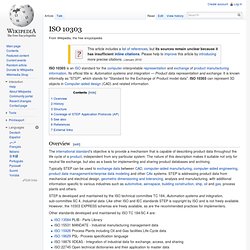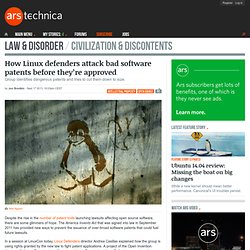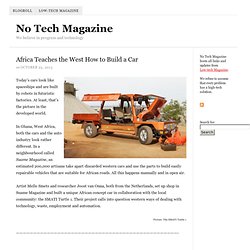

ISO 10303. ISO 10303 is an ISO standard for the computer-interpretable representation and exchange of product manufacturing information.

Its official title is: Automation systems and integration — Product data representation and exchange. It is known informally as "STEP", which stands for "Standard for the Exchange of Product model data". ISO 10303 can represent 3D objects in Computer-aided design (CAD) and related information. Overview[edit] Typically STEP can be used to exchange data between CAD, computer-aided manufacturing, computer-aided engineering, product data management/enterprise data modeling and other CAx systems. How Linux defenders attack bad software patents before they’re approved. Despite the rise in the number of patent trolls launching lawsuits affecting open source software, there are some glimmers of hope.

The America Invents Act that was signed into law in September 2011 has provided new ways to prevent the issuance of over-broad software patents that could fuel future lawsuits. In a session at LinuxCon today, Linux Defenders director Andrea Casillas explained how the group is using rights granted by the new law to fight patent applications. A project of the Open Invention Network, Software Freedom Law Center, and Linux Foundation, Linux Defenders examines the 6,000 new patent applications published each week, attempting to identify those that are potentially threatening to Linux and open source. Then, the group looks for prior art that would invalidate at least some of the claims in the patents. Africa Teaches the West How to Build a Car. Today’s cars look like spaceships and are built by robots in futuristic factories.

At least, that’s the picture in the developed world. In Ghana, West Africa, both the cars and the auto industry look rather different. In a neighbourhood called Suame Magazine, an estimated 200,000 artisans take apart discarded western cars and use the parts to build easily repairable vehicles that are suitable for African roads. All this happens manually and in open air. Artist Melle Smets and researcher Joost van Onna, both from the Netherlands, set up shop in Suame Magazine and built a unique African concept car in collaboration with the local community: the SMATI Turtle 1. Picture: The SMATI Turtle 1 Large cargo ships bring thousands of used cars from Europe to the African markets every week.
It is a self-organizing system capable of building almost anything using car parts; fences, swings, water pumps, carbide compressors, welding machines, but most of all vehicles adapted to the African market. Open Design Engine. How to Make Everything Ourselves: Open Modular Hardware. A modular system unites the advantages of standardisation (as parts can be produced cheaply in large amounts) with the advantages of customisation (since a large diversity of unique objects can be made with relatively few parts).

Modularity can be found to a greater or lesser extent in many products (like bicycles and computers) and systems (like trains and logistics), but the best examples of modular systems are toys: LEGO, Meccano, and Erector (which is now the brand name of Meccano in the US). LEGO, Meccano and Erector are composed of relatively few elementary building blocks, which can be used to build various objects. The parts can then be disassembled and re-used to build something completely different. Apart from the elementary buildings blocks, these manufacturers have produced many more specific building blocks, which are less versatile, but further increase customisation possibilities. Open Hardware Repository. Open Source Ecology. RepRap. TEDxEWB Talk: Adrian Bowyer at Imperial College, London, introduces RepRap RepRap is humanity's first general-purpose self-replicating manufacturing machine.

RepRap takes the form of a free desktop 3D printer capable of printing plastic objects. Since many parts of RepRap are made from plastic and RepRap prints those parts, RepRap self-replicates by making a kit of itself - a kit that anyone can assemble given time and materials. It also means that - if you've got a RepRap - you can print lots of useful stuff, and you can print another RepRap for a friend... RepRap is about making self-replicating machines, and making them freely available for the benefit of everyone. Reprap.org is a community project, which means you are welcome to edit most pages on this site, or better yet, create new pages of your own. MetalicaRap. MetalicaRap Release status: Experimental MetalicaRap is an open 3D metal & home solar cell printer, based on the principles of electron beam welding and vapor deposition.

MetalicaRap is currently in the design stage. The goal is to have affordable home-manufacturing of solar cells, key electrical parts and milled-quality metal parts[3][4][5]. An electron beam based printer was chosen due to the ability to print itself, the power efficiency of an electron gun versus a powerful laser at fusing metal, and the fact that an electron gun and vacuum chamber are the primary requirements for thin film solar cell printers.
One of the goals is a solar cell production plant design that MetalicaRap will be able to print, that will utilize MetalicaRap's vacuum chamber and beam for the solar cell manufacturing processes[6]. Congratulations Aleksander he has made the first home build electron beam welder!! Introduction Why an Open Design? What are the benefits? Metal Fabricated Home Japan SANAA 2005. Arduino - HomePage. The art of producing sustainable consumer goods: basketry. Picture: Big burden basket by Joe Hogan Baskets.

We tend to think of technology as rock and metal – from the Stone Age to the Iron Age, from pyramids and statues to Viking swords and pirate cannons. We think of the things that survive to be placed in museums, in other words, and tend to neglect the early and important inventions that ordinary people used every day but whose materials did not survive centuries of exposure. Picture: Joe Hogan Baskets. Citizen Science Alliance.